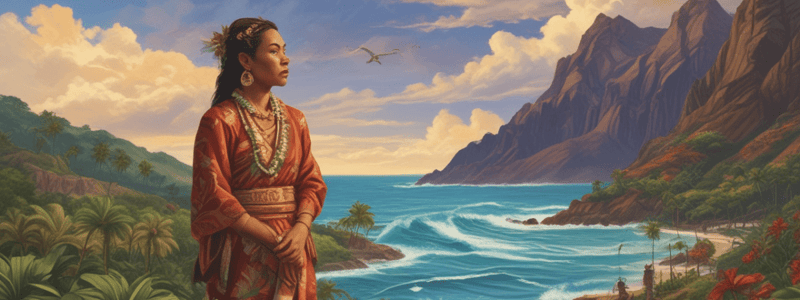Podcast
Questions and Answers
What is one of the areas that Dana Naone Hall has fought to protect?
What is one of the areas that Dana Naone Hall has fought to protect?
- Urban cities
- Industrial zones
- Commercial farms
- Wild areas including beaches, and valleys (correct)
What is the name of the organization created by Mililani Trask in 1987?
What is the name of the organization created by Mililani Trask in 1987?
- Hawaiian Sovereignty Movement
- Hawaiian Nation Organization
- Native Land Conservation
- Ka Lahui Hawai'i (correct)
What is one of Dana Naone Hall's occupations?
What is one of Dana Naone Hall's occupations?
- Lawyer
- Teacher
- Politician
- Land conservationist (correct)
Who has Mililani Trask worked with internationally?
Who has Mililani Trask worked with internationally?
What is the title of the anthology written by Dana Naone Hall?
What is the title of the anthology written by Dana Naone Hall?
What does Arnold Krupat criticize N. Scott Momaday's work as?
What does Arnold Krupat criticize N. Scott Momaday's work as?
What is the purpose of setting a blood quantum, according to Patricia Nelson Limerick?
What is the purpose of setting a blood quantum, according to Patricia Nelson Limerick?
What concept does N. Scott Momaday speak of in his work?
What concept does N. Scott Momaday speak of in his work?
What is the title of the book written by Patricia Nelson Limerick?
What is the title of the book written by Patricia Nelson Limerick?
What is the consequence of setting a blood quantum, according to the text?
What is the consequence of setting a blood quantum, according to the text?
What was the purpose of the Dawes General Allotment Act of 1887?
What was the purpose of the Dawes General Allotment Act of 1887?
What motivated the pressure for reform in Indian policy in the late 19th century?
What motivated the pressure for reform in Indian policy in the late 19th century?
What was the result of the Dawes General Allotment Act of 1887 on Indian tribal lands?
What was the result of the Dawes General Allotment Act of 1887 on Indian tribal lands?
What was the context in which the concept of blood quantum emerged?
What was the context in which the concept of blood quantum emerged?
What was a consequence of the assimilation policy embodied in the Dawes General Allotment Act?
What was a consequence of the assimilation policy embodied in the Dawes General Allotment Act?
Study Notes
Haunani-Kay Trask
- Born October 3, 1949, in the San Francisco Bay area, emigrated to Hawaii
- Holds a Ph.D. in Political Science from the University of Wisconsin (Madison), 1981
- Author of four books, including "From a Native Daughter: Colonialism and Sovereignty in Hawai‘i"
- Ranked one of the top Native leaders in a 2001 poll taken by The Honolulu Advertiser
Colonization of Hawai'i
- Dispossession of native Hawaiian lands justified by the idea that natives are "better off" as American citizens
- Overthrow of the Hawaiian monarchy in 1893, leading to annexation into the American protectorates in 1898
- Statehood achieved in 1959, with most lands and mineral rights transferred to "trusts" held by the federal government
- Loss of cultural significance, including the displacement of women from roles of power
Loss of Hawaiian-ness
- Federal government holds nearly two million acres of land, including waters and mineral rights, with little control by native Hawaiians
- Many Hawaiians have succumbed to the haole mentality of wealth, leading to the loss of Hawaiian culture
- By 1998, there was little standing for Hawaiians as a people within the Federal courts
Mana
- Refers to the power and authority that comes from leadership, fighting for people and lands, not just charisma or ancestry
- Mana is gained by following pono, or the Hawaiian value of balance between people, land, and the Cosmos
- Political leaders who have failed to care for their native people lack the power of mana
The Mana of Women
- Native women have lost their standing within their own land due to the acceptance of American culture and patriarchy
- Women have taken on a key role in fighting for their lands, people, and culture, with a focus on caring for the nation as an extension of caring for the family
Notable Native Women
- Pua Kanahele: a Kunu hula (master teacher) who has kept Hawaiian traditions alive through song and dance
- Dana Naone Hall: a poet and land conservationist who has worked to protect the islands' wild areas and cultural sites
- Mililani Trask: a lawyer and leader of the Hawaiian Sovereignty Movement, who has worked internationally to promote native rights
Blood Quantum
- Refers to the degree of ancestry from a specific race or ethnicity, used to determine membership in Native American tribes or nations
- Has been used to control and limit Native American land ownership and identity
- Examples of Blood Quantum laws include:
- Virginia law (1705) limiting colonial civil rights of Native Americans and persons of half or more Native American ancestry
- Dawes General Allotment (Severalty) Act of 1887
- Indian Reorganization Act of 1934
Critique of Blood Quantum
- Fails to recognize the complexity and diversity of Native American identity
- Has been used to define Native Americans out of existence
- Highlights the contradictions and limitations of using blood quantum to determine identity and membership
Studying That Suits You
Use AI to generate personalized quizzes and flashcards to suit your learning preferences.
Description
Learn about Haunani-Kay Trask, a prominent figure in Hawaiian sovereignty movement, from her background and academic achievements to her contributions as a professor and author of multiple books.
